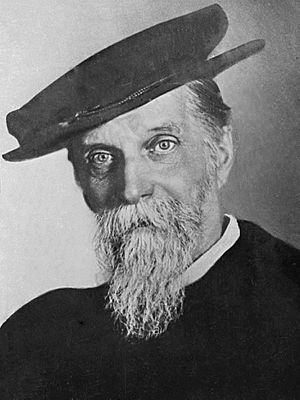Kliment Timiryazev facts for kids
Quick facts for kids
Kliment Timiryazev
|
|
|---|---|

Timiryazev in 1911
|
|
| Born | 22 May 1843 |
| Died | 28 April 1920 (aged 76) |
| Alma mater | Saint Petersburg State University |
| Awards | Croonian Lecture (1903) |
| Scientific career | |
| Fields | Botany, physiology |
| Institutions | Moscow State University |
| Thesis | Spectral analysis of chlorophyll (1871) |
Kliment Arkadievich Timiryazev (born May 22, 1843 – died April 28, 1920) was a famous Russian scientist. He was a botanist, studying plants, and a physiologist, studying how living things work. Timiryazev was very important in Russia for supporting Charles Darwin's ideas about evolution. He also started a special department and laboratory for studying plants at the Petrovskoye Academy.
Contents
A Scientist's Life: Kliment Timiryazev's Journey
Kliment Timiryazev was born in Saint Petersburg, Russia. His father, Arkady Semyenovich Timiryazev, was a Russian statesman. His mother, Adelaida Bode, was from England and had French roots. Kliment had three brothers.
Early Education and Studies Abroad
Timiryazev was taught at home by private teachers when he was young. In 1861, he started studying at Saint Petersburg State University. He graduated with high honors in 1866 from the physics and mathematics department.
Two years later, he wrote his first article about a device that studied how carbon dioxide breaks down. After this, he traveled abroad to learn from many famous scientists. These included Wilhelm Hofmeister, Robert Bunsen, and Hermann von Helmholtz.
Returning to Russia and Key Research
When Timiryazev came back to Russia in 1871, he earned his PhD. His research was about how to analyze chlorophyll using light. Chlorophyll is the green stuff in plants that helps them make food.
He became a professor at Petrov's Academy of Agriculture. He taught there until the academy closed in 1892. From 1877, he also gave lectures at Moscow State University.
His main research focused on photosynthesis. This is the amazing process where plants use sunlight to turn carbon dioxide and water into food. Timiryazev also was the first in Russia to use greenhouses for farming research. He started this in the early 1870s.
Honors and Memberships
Timiryazev was recognized for his important scientific work. He became a member of the Russian Academy of Sciences in 1890. In 1911, he joined the Royal Society in England and the Botanical Society of Scotland.
He also received honorary professor titles from several universities. These included the Saint Petersburg State University, University of Glasgow, and University of Cambridge.
Timiryazev believed that scientific research should happen in special institutes. These institutes would be separate from universities. This idea later became very common in how science was organized.
Promoting Darwin's Ideas in Russia
Kliment Timiryazev was a strong supporter of Charles Darwin's theory of evolution in Russia. In 1877, he even visited Darwin at his home, Down House, in England.
Timiryazev's View on Evolution
Timiryazev wrote many works to promote Darwinism. He also translated Darwin's famous book, On the Origin of Species, into Russian.
However, he did not like the term "struggle for existence" that Darwin used. Timiryazev thought this phrase was a bad way to describe nature. He felt it had negative social meanings. He believed that Darwin's ideas could be taught without using the word "struggle."
Influencing Future Scientists
At the University of Moscow, a young scientist named Alexander Oparin attended Timiryazev's private lectures. These lectures about evolution greatly influenced Oparin's own scientific work. Timiryazev also gave talks about Darwinism in his own home in Moscow.
Timiryazev's Lasting Legacy
Many things are named after Kliment Timiryazev to honor his contributions to science.
Places and Institutions Named After Him
- The Moscow Agricultural Academy is known as the Timiryazev Agricultural Academy.
- A station on the Moscow Metro, Timiryazevskaya, is named after him.
- A crater on the Moon is called Timiryazev.
- An asteroid, 6082 Timiryazev, also carries his name.
- The Regional Universal Scientific Library in Vinnytsia is named after Kliment Timiryazev.
- The Timiryazev State Museum of Biology in Moscow is also named in his honor.
The Timiryazev Statue in Moscow
At the start of the Tverskoy Boulevard in Moscow, there is a statue of Timiryazev. It was revealed on November 4, 1923. The famous sculptor Sergey Merkurov created it.
The statue shows Timiryazev wearing the special gown of University of Cambridge. He received an honorary doctorate from that university. The stone base of the statue has an inscription about the "curve of plant physiology." This refers to an important scientific discovery Timiryazev made.
In October 1941, during a war, a bomb hit the statue and knocked it over. But just a few hours later, it was put back in its place. You can still see marks on the lower part of the statue from the bomb pieces.
Selected Publications
- The Life Of The Plant (1958 English edition)
Images for kids


